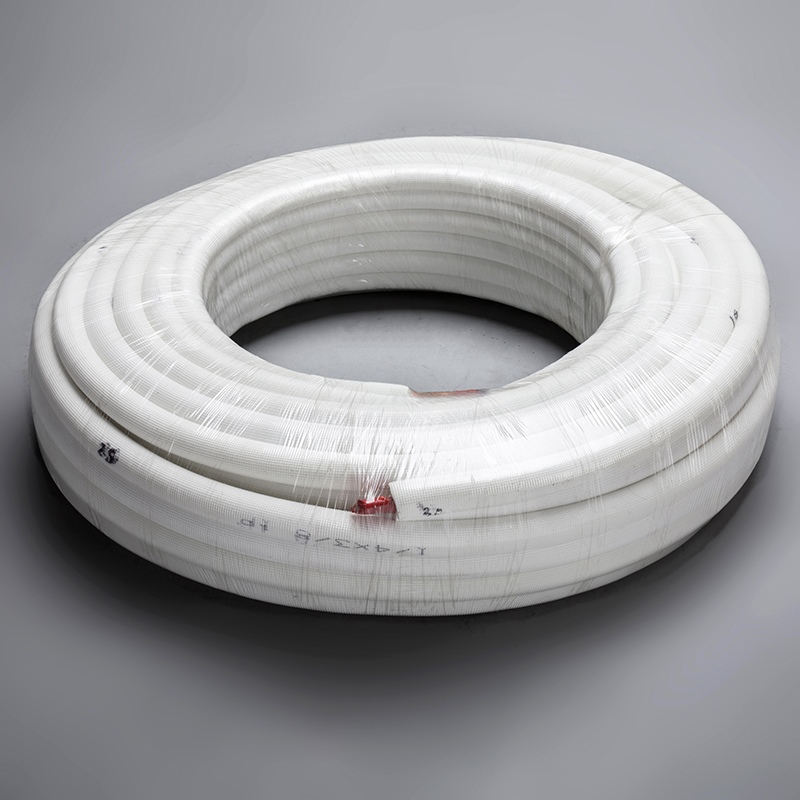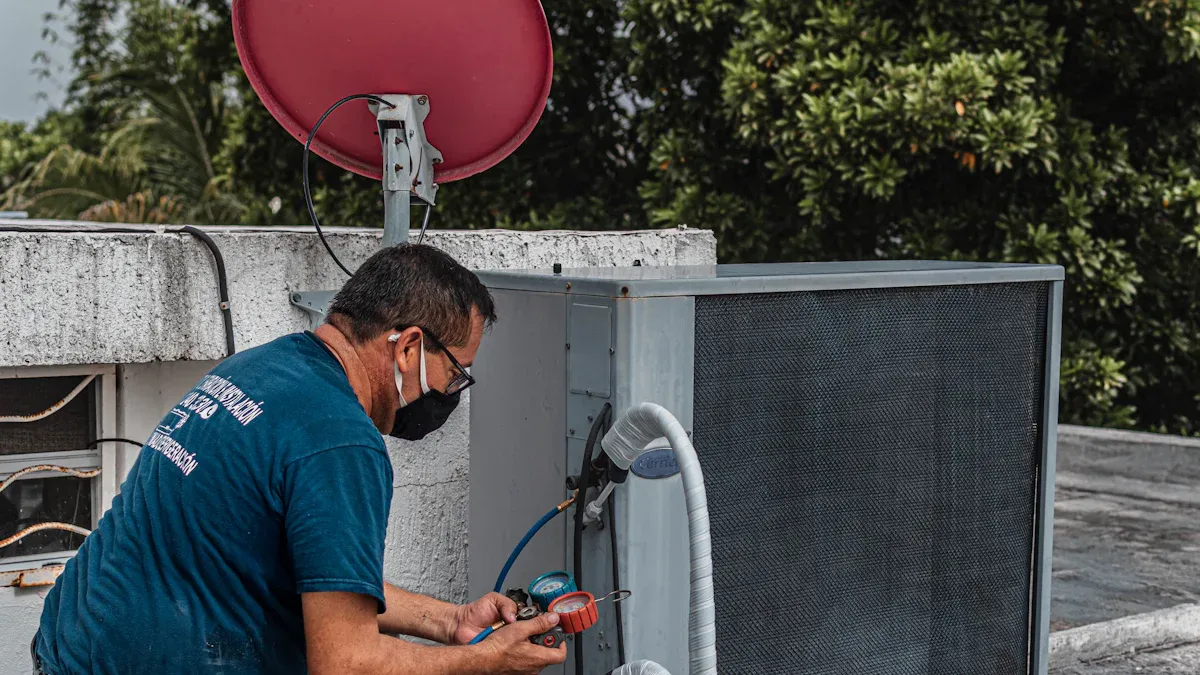A Step-by-Step Guide to Copper Tubing for Air Conditioning

Choosing the right copper tubing for air conditioning is important. It helps systems work better, last longer, and use less energy. For example, HVAC systems with thin copper tubing (0.71mm thick) improve heat transfer. This meets Brazil’s energy rules. In Europe, thicker copper walls, used in R290 and R32 systems, boost efficiency by 20%. Copper is great at carrying heat and resisting rust. This makes it essential for air conditioning systems, helping refrigerants move and cool better.
Key Takeaways
Picking the right copper tubing makes air conditioning work better and last longer. Think about your system's cooling needs and pressure levels.
Copper tubing types K, L, and M have different uses. Type K handles high pressure, Type L bends easily for medium pressure, and Type M works for low pressure.
Always make sure the tubing meets rules like EN 12735. Approved copper tubing is safer, works well, and helps stop leaks.
Installing it correctly is very important. Measure carefully, use proper tools, and check for leaks to keep your air conditioning running well.
Checking and fixing copper tubing often helps it last longer. Clean the tubes and look for damage to keep your system working properly.
Types of Copper Tubing for Air Conditioning

When picking copper tubes for air conditioning, know the types. Each type has special features for different cooling needs.
Type K Copper Tubing
Type K tubing is the strongest and most durable. Its thick walls resist rust and handle high pressure well. This makes it perfect for HVAC and cooling systems needing strength. It transfers heat efficiently, which is key for cooling. Copper is recyclable, so Type K is eco-friendly. But its thickness makes it less bendable, so it’s hard to use in tight spots.
Type L Copper Tubing
Type L tubing is a flexible and strong option. Its walls are thinner than Type K but still resist rust. It’s often used in homes and businesses for air conditioning. Its mix of strength and flexibility makes it easy to install. It also transfers heat well, keeping systems efficient. However, it’s not ideal for systems needing very high pressure.
Type M Copper Tubing
Type M tubing is the cheapest and lightest choice. Its thin walls make it easy to carry and use. It’s mostly used in plumbing but works for low-pressure cooling systems too. It costs less but isn’t as strong or rust-resistant. Because of this, it’s not good for HVAC systems needing long-lasting performance.
Tip: Check your system’s needs to pick the right copper tubing.
DWV Copper Tubing
DWV copper tubing is made for special uses like drainage. It is used in systems that do not need high pressure. This type of tubing is not good for air conditioning systems.
Key Features of DWV Copper Tubing:
Thin Walls: DWV tubing has thinner walls than Type K, L, or M. It is light and simple to use.
Low Pressure Tolerance: It cannot handle high pressure, so it is not for HVAC systems.
Cost-Effective: It is cheaper because it is made for low-pressure jobs.
Note: Do not use DWV tubing in air conditioning systems. It cannot handle refrigerant pressure and may cause problems.
When to Use DWV Copper Tubing
DWV tubing is good for plumbing where pressure is not needed. Examples include:
Removing gases from drainage systems.
Moving wastewater in homes or offices.
Why DWV Tubing is Not Ideal for Air Conditioning
Air conditioning needs strong tubing that handles high pressure and resists rust. DWV tubing is not strong enough for this. Using it in air conditioning can cause safety and performance issues.
Tip: Always check your system’s pressure needs before choosing copper tubing. This helps you pick the right type for the best results.
Key Factors to Think About When Picking Copper Tubing
Tubing Size and Diameter
Picking the right pipe size is very important. The size of copper pipes controls how much refrigerant moves through. Pipes that are too small slow down refrigerant flow. This makes cooling less effective. Pipes that are too big cost more and are harder to install.
Rules like EN 12735 make sure copper pipes meet aircon needs. These rules ensure pipes are strong and reliable for HVAC systems.
When choosing pipe size, think about your aircon’s cooling power. Bigger systems need wider pipes for more refrigerant. Smaller systems can use thinner pipes, which are cheaper and easier to fit.
Tip: Check the maker’s guide to find the best pipe size for your aircon.
Wall Thickness and Pressure Ratings
The thickness of pipe walls is key for handling pressure. Thicker walls are better for high-pressure refrigerants. They keep the system safe and working well.
Type K tubing has thick walls, perfect for high pressure. Type L tubing balances strength and flexibility for medium pressure. Type M tubing has thin walls, good for low pressure but not very durable.
The copper tube market was worth USD 35.19 billion in 2023. It is expected to grow by over 3.5% yearly from 2024 to 2032. This shows more people want energy-saving HVAC systems that use copper for its strength and long life.
Note: Make sure your copper pipes follow rules like EN 12735 to handle pressure safely.
Insulation and Installation Space
Insulated copper pipes are important for keeping aircon systems efficient. Insulation stops heat loss and condensation, keeping refrigerants at the right temperature.
Different places need different insulation thicknesses based on weather and use. For example:
Region | Insulation Thickness | Application Type |
|---|---|---|
North America | >25mm | Heating systems |
Mediterranean | 15mm | Milder conditions |
Southeast Asia | N/A | Cooling systems |
Saudi Arabia | N/A | High-pressure refrigerants |
When installing, think about the space for pipes. Tight spaces need flexible insulated pipes. Bigger spaces can use stiff pipes.
Copper is great at carrying heat and resisting rust. Insulated copper pipes make these features even better. This helps systems work well and last longer.
Tip: Pick insulated copper pipes that fit your system and space to get the best results.
Material Purity and Quality
The purity of copper is very important for aircon systems. Pure copper pipes help refrigerants flow smoothly and last longer. They also resist rust, keeping your system working well. When picking copper tubing, choose high-purity materials. This avoids problems like leaks, poor performance, and expensive fixes.
Why Material Purity Matters
Dirty copper can rust faster, especially in wet places. Local copper often has over 0.25% impurities, which causes damage. This weakens insulated pipes and makes cooling less effective. Pure copper, cleaned with special methods like electrolytic refining, reaches 99.99% purity. This improves heat transfer and protects against weather damage.
Quality Assurance in Copper Manufacturing
Copper makers follow strict rules to keep it pure. For example, ISO 1337:2021 limits sulfur to ≤0.002%. This keeps copper strong and safe from chemical damage. South Korean factories use advanced methods to make very pure copper pipes. These pipes cost 8-12% more but work better and last longer.
Impact of Substandard Copper
Bad copper can cause big issues. In Vietnam, 15% of copper pipes were returned due to leaks. This was because of poor-quality local copper. Such problems show why good copper is important. High-purity copper may cost more at first but saves money later by needing fewer repairs.
Comparing Material Purity
The table below shows how purity affects copper tubing:
Aspect | Evidence |
|---|---|
Cost of High-Purity Copper | Pure copper pipes cost 8-12% more but perform better. |
Impurity Levels | Local copper often has over 0.25% impurities, causing rust. |
Compliance Standards | ISO 1337:2021 limits sulfur to ≤0.002%, ensuring durability. |
Manufacturing Techniques | South Korea uses electrolytic refining for 99.99% pure copper. |
Market Impact | Vietnam had 15% pipe returns due to bad local copper. |
How to Ensure Quality
To get good copper tubing, check for purity certifications. Pipes meeting ISO standards are more reliable. Also, check where the copper comes from. Trusted makers using advanced refining methods offer better pipes. These pipes handle tough conditions and last longer.
Tip: Always pick pure copper for your aircon system. It works better, lasts longer, and saves money over time.
Compliance with Standards for Aircon Piping Installation
Important Standards (e.g., EN 12735, ASTM B280, AS/NZS 1571)
When setting up aircon pipes, follow recognised standards. These rules ensure your system is safe, efficient, and long-lasting. For instance, EN 12735 tubes are made for aircon and refrigeration. They meet strict rules for strength and purity, working well under high pressure.
ASTM B280 requires seamless copper tubes with at least 99.9% purity. This stops contamination and keeps refrigerants flowing smoothly. AS/NZS 1571, created in 1995, sets rules for seamless copper tubes made from phosphorus-deoxidised copper. This is vital for systems using refrigerants like R32 or R410A, which need thicker walls for higher pressures.
Checking Compliance
To check compliance, review certifications and documents from manufacturers. Look for standards like IS 10773:1995 and ASTM B280-23. These guide how copper tubing is made and used in aircon systems. Manufacturers use advanced tools, like pressure testers, to meet these standards.
Inspections happen at different stages, such as material checks, process inspections, and final testing. These steps ensure the copper tubing is defect-free and meets all requirements.
Advantages of Certified Copper Tubing
Certified copper tubing has many benefits. It ensures your aircon pipes follow safety and performance rules. High-quality EN 12735 tubes resist rust and handle high-pressure refrigerants well. They reduce leaks and system breakdowns, saving repair costs.
Certified tubes improve heat transfer, boosting your aircon’s performance. They also give you confidence that your system meets industry standards and will last a long time.
Tip: Always pick certified copper tubing for a safe and reliable aircon system.
Step-by-Step Guide to Choosing Copper Tubing for Air Conditioning
Check Cooling Needs and System Details
First, figure out how much cooling your system needs. This tells you how much refrigerant must flow through the pipes. Bigger systems need wider pipes for more refrigerant. Smaller systems can use thinner pipes and still work well.
Think about your system’s pressure and temperature. High-pressure systems, like those using R410A refrigerants, need thicker pipes. These pipes are safer and last longer. Low-pressure systems can use thinner pipes, but they must meet basic standards.
Tip: Match the pipe size and type to your system’s cooling needs. This avoids mistakes and keeps your system efficient.
Follow Manufacturer Guidelines
Manufacturers give important advice for picking copper pipes. Their guides show the right size, thickness, and quality for your system. Following these tips ensures the pipes fit and work well.
Look for these key points in the guidelines:
Durability: Good copper pipes can last as long as the building.
Corrosion Resistance: Copper doesn’t rust easily if installed correctly.
Vibration Control: Pipes should handle movement without breaking at bends.
Certification Standards: Pipes should meet NSF/ANSI 61 for safety in water systems.
Note: Manufacturer guides are made for your system. Use them to avoid errors and ensure your system works reliably.
Pick the Right Type and Size
Choosing the correct copper pipe type and size is very important. Start by finding the type that matches your system’s pressure and strength needs. Type K pipes are thick and strong for high-pressure systems. Type L pipes are flexible and durable for medium pressure. Type M pipes are thin and cheap but only good for low-pressure systems.
Next, choose the right size for your refrigerant flow. Pipes that are too small slow down refrigerant, reducing cooling. Pipes that are too big cost more and are harder to install.
Pipe Type | Best Use | Main Features |
|---|---|---|
Type K | High-pressure systems | Thick walls, very strong |
Type L | Medium-pressure systems | Flexible and durable |
Type M | Low-pressure systems | Thin walls, affordable |
Tip: Check your system’s manual to find the best pipe type and size for top performance.
Ensure Proper Installation Practices
Installing copper tubing correctly is key for your aircon system. Good installation helps it work well and last longer. Skipping proper steps can cause poor cooling, higher bills, and frequent fixes.
Key Practices for Proper Installation:
Measure and Cut Carefully: Use the right tools to measure and cut tubing. Wrong sizes can cause leaks or bad connections.
Smooth the Edges: After cutting, smooth the edges to avoid seal damage. This ensures a snug fit.
Use Special Tools: Use tools like tube benders and flaring tools. These keep the tubing in good shape.
Tighten Connections: Make sure all fittings are tight. Loose ones can leak refrigerant and lower efficiency.
Check for Leaks: Test for leaks with a pressure gauge or detector. This ensures the system is sealed and ready.
Tip: Follow the maker’s instructions during installation. These are made for your system and help avoid errors.
Why Proper Installation Matters:
Correct installation affects how well your aircon works. For example:
Right-sized pipes improve cooling and save energy.
A plastics company found low compressor pressure due to bad pipe sizing. This shows why accurate installation is crucial.
Experts say wrong setups can raise bills and need more repairs.
By following these steps, your aircon will work better and last longer.
Avoid Common Mistakes in Aircon Piping Installation
Mistakes during installation can harm your aircon’s performance and safety. Knowing and avoiding these errors saves time and money.
Common Mistakes to Avoid:
Wrong Tubing Type: Each system needs specific tubing. Using the wrong one can cause pressure problems or failure.
Bad Sizing: Small pipes block refrigerant flow. Big pipes cost more and are harder to fit.
Skipping Insulation: Uninsulated pipes can cause water damage and lower efficiency.
Overtightening Fittings: Tightening too much can break pipes and cause leaks.
Skipping Leak Tests: Not testing for leaks can leave refrigerant escaping, harming the system and environment.
How to Avoid These Mistakes:
Plan First: Check your system’s needs and gather tools before starting.
Measure Twice: Take time to measure and check your numbers.
Follow Rules: Make sure your work meets standards like EN 12735 and ASTM B280.
Inspect Everything: After finishing, check all connections and test the system.
Note: Don’t rush the job. Doing it right saves you from costly problems later.
Avoiding these mistakes ensures your aircon runs smoothly and efficiently.
Maintenance and Lifespan of Copper Tubing
Regular Inspection and Cleaning
Regular checks keep your aircon system working well for longer. Inspect and clean insulated copper tubes every year to maintain their condition. Dirty or blocked tubes make the system less effective and use more energy.
Testing often finds problems early, avoiding expensive repairs.
Clean heat exchangers protect most HVAC parts, improving reliability.
Annual coil cleaning keeps the system running efficiently.
Clean coils help your aircon cool better and save energy. Skipping this step can lower cooling power and raise electricity costs. Use a soft brush or vacuum to clear dirt from the tubes. For tough grime, use a mild cleaner suggested by the maker.
Tip: Call a professional if you hear strange noises or notice poor cooling.
Identifying Wear and Corrosion
Wear and rust can harm copper pipes in your aircon system. Finding these issues early stops leaks and system failure. Special tools like ER and LPR sensors check pipe conditions.
Sensor Type | Measurement Range | Notes |
|---|---|---|
ER Sensor | 0–10 mils | Tracks metal loss instantly |
LPR Sensor | 0–200 MPY | Shows rust speed but struggles in harsh conditions |
Rust rates change with the environment. For example, at 25 °C with no salt, the rate is 4 MPY. With 1.75% salt at the same temperature, it jumps to 190 MPY. Hot and salty places speed up rust, so regular checks are vital.
Note: Watch for signs like colour changes, small holes, or leaks to catch problems early.
Extending the Lifespan of Copper Tubing
You can do many things to make copper pipes last longer. Copper’s natural rust resistance and chemical strength make it a great choice for aircon systems.
Insulated copper tubes stop heat loss and water drops, saving energy.
Copper’s smooth surface reduces wear, keeping it reliable for years.
Its eco-friendly production uses less energy.
Copper pipes last longer than plastic ones. They resist chemical damage, lowering the chance of cracks or leaks. This strength keeps your aircon system working for a long time.
Tip: Choose certified copper tubing and follow correct installation steps for the best results.
Picking the right copper tubing helps your aircon work well. Good copper tubing has many benefits. It carries heat easily, doesn’t rust, and stays strong in tough conditions. These qualities save energy, need less fixing, and make the system more reliable.
Copper lasts a long time and can be recycled, making it eco-friendly. Using certified materials and following rules avoids expensive repairs. This also keeps your system running smoothly. The table below shows why high-quality copper tubing is worth it:
Aspect | Benefit |
|---|---|
Lifespan | Copper lasts long, so fewer replacements are needed. |
Maintenance Needs | Needs little care, saving money over time. |
Thermal Conductivity | Moves heat well, making aircon use less energy. |
Corrosion Resistance | Doesn’t rust easily, keeping the system safe and reliable. |
Environmental Stress Resistance | Handles tough weather, staying strong and durable. |
Choosing the best copper tubing improves your aircon and helps the planet. Make smart choices for lasting benefits and worry-free use.
FAQ
Why is copper tubing good for air conditioning systems?
Copper tubing moves heat well and doesn’t rust easily. It helps refrigerants flow smoothly, making cooling better. Its strength makes it a dependable choice for aircon systems.
How can I pick the right copper tubing for my aircon?
Look at your system’s cooling needs and pressure levels. Choose the tubing type and size that matches these. Type K is best for high pressure, while Type L fits medium pressure systems.
Can DWV copper tubing be used for air conditioning?
No, DWV tubing isn’t strong enough for aircon systems. It’s made for drainage and low-pressure jobs, not high-pressure cooling.
How often should copper tubing in aircon systems be checked?
Check copper tubing once a year for damage or leaks. Regular checks keep your system working well and lasting longer.
Why does copper tubing need insulation?
Insulation stops heat loss and water drops. It keeps refrigerants at the right temperature, helping your aircon work better.
See Also
Simple Guide: Professionally Install Copper Tubes for AC
Discovering How Copper Tubing Has Evolved in AC Systems
Comprehensive DIY Manual for Repairing AC Copper Tube Leaks
Exploring the Significance of Copper Tubing in AC Systems
Looking Ahead: Future Trends in Copper Tube Production for AC


